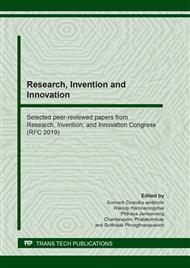[1]
T.P. Haider, C. Volker, J. Kramm, K. Landfester, F.R. Wurm, Plastics of the Future? The Impact of Biodegradable Polymers on the Environment and on Society, Angew. Chem. Int. Ed. 58 (2019) 50-62.
DOI: 10.1002/anie.201805766
Google Scholar
[2]
C.Y. Barlow, D.C. Morgan, Polymer film packaging for food: An environmental assessment, Resour. Conserv. Recycl. 78 (2013) 74-80.
Google Scholar
[3]
C.J. Moore, Synthetic polymers in the marine environment: A rapidly increasing, long-term threat, Environ. Res. 108 (2008) 131-139.
DOI: 10.1016/j.envres.2008.07.025
Google Scholar
[4]
M. Eriksen, N. Maximenko, M. Thiel, A. Cummins, G.Lattin, S. Wilson, J. Hafner, A. Zellers, S. Rifman, Plastic pollution in the South Pacific subtropical gyre, Mar Pollut. Bull. 68 (2013) 71-76.
DOI: 10.1016/j.marpolbul.2012.12.021
Google Scholar
[5]
L.C. de Sáa, M. Oliveirab, F. Ribeiroc, T.L. Rochad, M.N. Futter, Studies of the effects of microplastics on aquatic organisms: What do we know and where should we focus our efforts in the future?, Sci. Total Environ. 645 (2018) 1029-1039.
DOI: 10.1016/j.scitotenv.2018.07.207
Google Scholar
[6]
S. Zhang, J. Wang, X. Liu, F. Qu, X. Wang, X. Wang, Y. Li, Y. Sun, Microplastics in the environment: A review of analytical methods, distribution, and biological effects, Trends Anal. Chem. 111 (2019) 62-72.
DOI: 10.1016/j.trac.2018.12.002
Google Scholar
[7]
M.A. Browne, P. Crump, S.J. Niven, E. Teuten, A. Tonkin, T. Galloway, R. Thompson, Accumulation of Microplastic on Shorelines Woldwide: Sources and Sinks, Environ. Sci. Technol. 45(2011) 9175-9179.
DOI: 10.1021/es201811s
Google Scholar
[8]
V. Hidalgo-Ruz, L. Gutow, R.C. Thompson, M. Thiel, Microplastics in the Marine Environment: A Review of the Methods Used for Identification and Quantification, Environ. Sci. Technol. 46 (2012) 3060-3075.
DOI: 10.1021/es2031505
Google Scholar
[9]
S. Mizuno, T. Maeda, C. Kanemura, A. Hotta, Biodegradability, reprocessability, and mechanical properties of polybutylene succinate (PBS) photografted by hydrophilic or hydrophobic membranes, Polym. Degrad. Stabil. 117 (2015) 58-65.
DOI: 10.1016/j.polymdegradstab.2015.03.015
Google Scholar
[10]
N. Lucasa, C. Bienaime, C. Belloy, M. Queneudec, F. Silvestre, J.-E. Nava-Saucedo, Polymer biodegradation: Mechanisms and estimation techniques – A review, Chemosphere, 73(2008) 429-442.
DOI: 10.1016/j.chemosphere.2008.06.064
Google Scholar
[11]
S. Doppalapudia, A. Jaina, W. Khana, A.J. Domb, Biodegradable polymers—an overview, Polym. Adv. Technol. 25 (2014) 427-435.
DOI: 10.1002/pat.3305
Google Scholar
[12]
G.E. Luckachan, C.K.S. Pillai, Biodegradable Polymers- A Review on Recent Trends and Emerging Perspectives, J. Polym. Environ. 19 (2011) 637-676.
DOI: 10.1007/s10924-011-0317-1
Google Scholar
[13]
H.-S. Kim, H.-S. Yang, H.-J. Kim, Biodegradability and Mechanical Properties of Agro-Flour– Filled Polybutylene Succinate Biocomposites, J. Appl. Polym. Sci. 97(2005) 1513-1521.
DOI: 10.1002/app.21905
Google Scholar
[14]
J. Zhou, X. Wang, K. Hua, C. Duan, W. Zhang, J. Ji, X. Yang, Enhanced mechanical properties and degradability of poly(butylene succinate) and poly(lactic acid) blends, Iran Polym. J. 22 (2013) 267-275.
DOI: 10.1007/s13726-013-0124-8
Google Scholar
[15]
T. Yokohara, M. Yamaguchi, Structure and properties for biomass-based polyester blends of PLA and PBS, Eur. Polym. J. 44 (2008) 677-685.
DOI: 10.1016/j.eurpolymj.2008.01.008
Google Scholar
[16]
Roohi, M. R. Zaheer, M. Kuddus, PHB (poly‐β‐hydroxybutyrate) and its enzymatic degradation, Polym Adv Technol. 29 (2018) 30-40.
DOI: 10.1002/pat.4126
Google Scholar
[17]
M. Bartnikowskia, T.R. Dargaville, S. Ivanovski, D.W. Hutmacher, Degradation mechanisms of polycaprolactone in the context of chemistry, geometry and environment, Prog. Polym. Sci. 96 (2019) 1-20.
DOI: 10.1016/j.progpolymsci.2019.05.004
Google Scholar
[18]
K.P. Andriano, Y. Tabata, Y. Ikada, J. Heller, In vitro and in vivo comparison of bulk and surface hydrolysis in absorbable polymer scaffolds for tissue engineering. J Biomed. Mater. Res. 48(1999) 602-612.
DOI: 10.1002/(sici)1097-4636(1999)48:5<602::aid-jbm3>3.0.co;2-6
Google Scholar
[19]
F. von Burkersroda, L. Schedl, A. Go¨pferich, Why degradable polymers undergo surface erosion or bulk erosion. Biomaterials 23(2002) 4221-4231.
DOI: 10.1016/s0142-9612(02)00170-9
Google Scholar
[20]
T.D. Farahani, A.A. Entezami, M. Abtahi, Degradation of poly(D, L-lactide-co-glycolide) 50:50 implant in aqueous medium, Iran Polym J. 14 (2005) 753-763.
Google Scholar
[21]
A. Go¨pferich, Polymer bulk erosion, Macromolecules 30 (1997) 2598-2604.
Google Scholar
[22]
S. Su, R. Kopitzky, S. Tolga, S. Kabasci, Polylactide (PLA) and Its Blends with Poly(butylene succinate) (PBS): A Brief Review, Polymer 11 (2019) 1193, 1-21.
DOI: 10.3390/polym11071193
Google Scholar
[23]
A.L. Andrady, Assessment of Environmental Biodegradation of Synthetic Polymers, J. Macromol. Sci. Polym. Rev. 34 (1994) 25-76.
Google Scholar
[24]
C. Boonmee, C. Kositanont, T. Leejarkpai, Degradation of Poly (lactic acid) under Simulated Landfill Conditions, Environ. Nat. Resour. J. 14 (2016)1-9.
Google Scholar
[25]
R. Muthuraj, M. Misra, A.K. Mohanty, Hydrolytic degradation of biodegradable polyesters under simulated environmental conditions, J. Appl. Polym. Sci. 42189 (2015) 1-13.
DOI: 10.1002/app.42189
Google Scholar
[26]
M.A. Elsawya, K.-H. Kimc, J.-W. Parkc, A. Deep, Hydrolytic degradation of polylactic acid (PLA) and its composites, Renew. Sust. Energ. Rev. 79 (2017) 1346-1352.
Google Scholar
[27]
A. M. Harris and E.C. Lee, Durability of Polylactide-Based Polymer Blends for Injection-Molded Applications, J. Appl. Polym. Sci. (2013) 2136-2144.
DOI: 10.1002/app.38407
Google Scholar
[28]
X. Hu1, T. Su1, P. Li1, Z. Wang, Blending modification of PBS/PLA and its enzymatic degradation, Polym. Bull. 75 (2018) 533-546.
DOI: 10.1007/s00289-017-2054-7
Google Scholar


